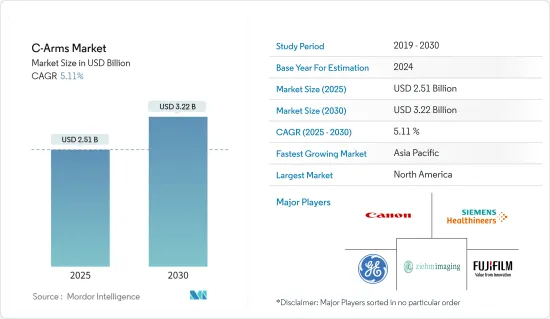PUBLISHER: Mordor Intelligence | PRODUCT CODE: 1686662

PUBLISHER: Mordor Intelligence | PRODUCT CODE: 1686662
C-Arms - Market Share Analysis, Industry Trends & Statistics, Growth Forecasts (2025 - 2030)
The C-Arms Market size is estimated at USD 2.51 billion in 2025, and is expected to reach USD 3.22 billion by 2030, at a CAGR of 5.11% during the forecast period (2025-2030).

The COVID-19 pandemic is expected to have an impact on the C-arms market. C-arms are used in image-guided procedures that are mostly elective, which were postponed due to COVID-19. This postponement also resulted in hospitals deterring investments in high-cost capital equipment during the pandemic, as they focused more on ventilators or other COVID-19 treatment supporting equipment. According to a study published in the British Journal of Surgery, in May 2020, based on a 12-week period of peak disruption in the hospital services due to COVID-19, around 28.4 million elective surgeries worldwide were canceled or postponed in 2020. More than 580,000 planned surgeries in India were canceled or delayed due to the COVID-19 pandemic. However, according to the European Association of Urology guideline, while handling COVID-19 positive patients needing surgery, a specially equipped operating room needs to be designed, where a mobile C-arm fluoroscopic X-ray system for radiology and healthcare professionals will be needed for operating. Hence, considering the rising cases of COVID-19 and their significant effect on healthcare systems across the region, the market is projected to continue the steady growth rate trajectory during the forecast period.
The major factors driving the market's growth include the rising geriatric population, increasing incidence of chronic diseases, advancements in maneuverability and imaging capabilities, and increasing demand for imaging technologies from emerging economies.
Imaging systems are becoming an essential technology found in nearly all well-equipped hospitals. Specialists in surgery, orthopedics, traumatology, vascular surgery, and cardiology use C-arms for intraoperative imaging. The devices provide high-resolution X-ray images in real-time, which help physicians monitor progress at any point during the operation and immediately make necessary corrections. As a result, treatment results are better, with faster recovery. C-arms are currently being used in several areas of medicine, and their applications are expected to increase over time. These factors, along with the increasing demand for healthcare infrastructure in developing countries, are driving the C-arms market. The emerging market economies include India, Mexico, Russia, Pakistan, Saudi Arabia, China, and Brazil. Critically, an emerging market economy is transitioning from a low income, less developed, often pre-industrial economy toward a modern, industrial economy with a higher standard of living. The primary reason for the rising demand for C-arms is rising healthcare expenditure, continuous advancement in the products, and increasing surgical procedures.
The burden of cancer is continuously increasing in India. According to the World Health Organization, in 2020, about 1,324,413 new cancer cases were reported in India. Similarly, according to the GLOBOCAN, in 2020, around 27,885 new cancer cases were reported in Saudi Arabia, with about 13,069 cancer-related deaths. Companies are constantly expanding and introducing new products in these emerging countries. For instance, in January 2020, Trivitron Healthcare, an India-based company, launched Elite - Flat Panel Digital C-arm with motorized movements. The rising number of hospitals and clinics and advancing healthcare infrastructure in these countries are leading to the growing adoption of technologically advanced C-arm systems, such as digital C-arms. However, the high cost of C-arm systems and the growing use of refurbished devices may restrain the market studied.
C-Arms Market Trends
Mini C-arm Segment is Expected to Show Better Growth During the Forecast Period
Mini C-arms are designed explicitly for extremity imaging. They have a smaller footprint and increased mobility compared to full-size C-arms. The mini C-arm category varies significantly in size and cost depending upon the functionalities offered. Manufacturers are differentiating their products based on mobility, the field of view, and alternate imaging technologies. The factors driving the growth of the segment include increasing usage of mini C-arms due to their portability, increasing product developments, and rising product approvals are among the major factors elevating the market growth.
The mini C-arms segment is expected to witness several product launches during the forecast period, as companies are upgrading their product offerings at a fast pace. For instance, in November 2021, Fujifilm launched the new Persona CS mobile fluoroscopy system, the compact mobile C-arm imaging solution designed for rapid and seamless positioning in the operating room
Moreover, in June 2021, Turner Imaging Systems, a developer of advanced X-ray imaging systems, stated that the company received its CE Mark for its Smart-C Mini C-Arm portable fluoroscopy X-ray imaging device. This will allow the Smart-C portable mini c-arm, to be distributed throughout the EU countries as well as the UK. Thereby, such product approvals is going to elevate the growth of the segment.
Additionally, in April 2021, Ziehm Imaging and Carestream Health stated that they have added a new mobile C-arm into its growing innovative product portfolio, known as the Ziehm Vision RFD C-arm, this surgical imaging system will further enhance Carestream's mobile and fluoroscopic product offerings to benefit even more healthcare providers. Thereby, such product developments are increasing the segment growth, hence elevating the market growth.
Therefore, the mini C-arms segment is expected to witness significant growth over the forecast period due to the abovementioned factors
North America Held the Healthy Share in the Market Studied
C-Arms Industry Overview
Additional Benefits:
TABLE OF CONTENTS
1 INTRODUCTION
- 1.1 Study Assumptions and Market Definition
- 1.2 Scope of the Study
2 RESEARCH METHODOLOGY
3 EXECUTIVE SUMMARY
4 MARKET DYNAMICS
- 4.1 Market Overview
- 4.2 Market Drivers
- 4.2.1 Rising Geriatric Population and Increasing Incidence of Chronic Diseases
- 4.2.2 Advancements in Maneuverability and Imaging Capabilities
5 MARKET SEGMENTATION (Market Size by Value - USD million)
6 COMPETITIVE LANDSCAPE
7 MARKET OPPORTUNITIES AND FUTURE TRENDS




